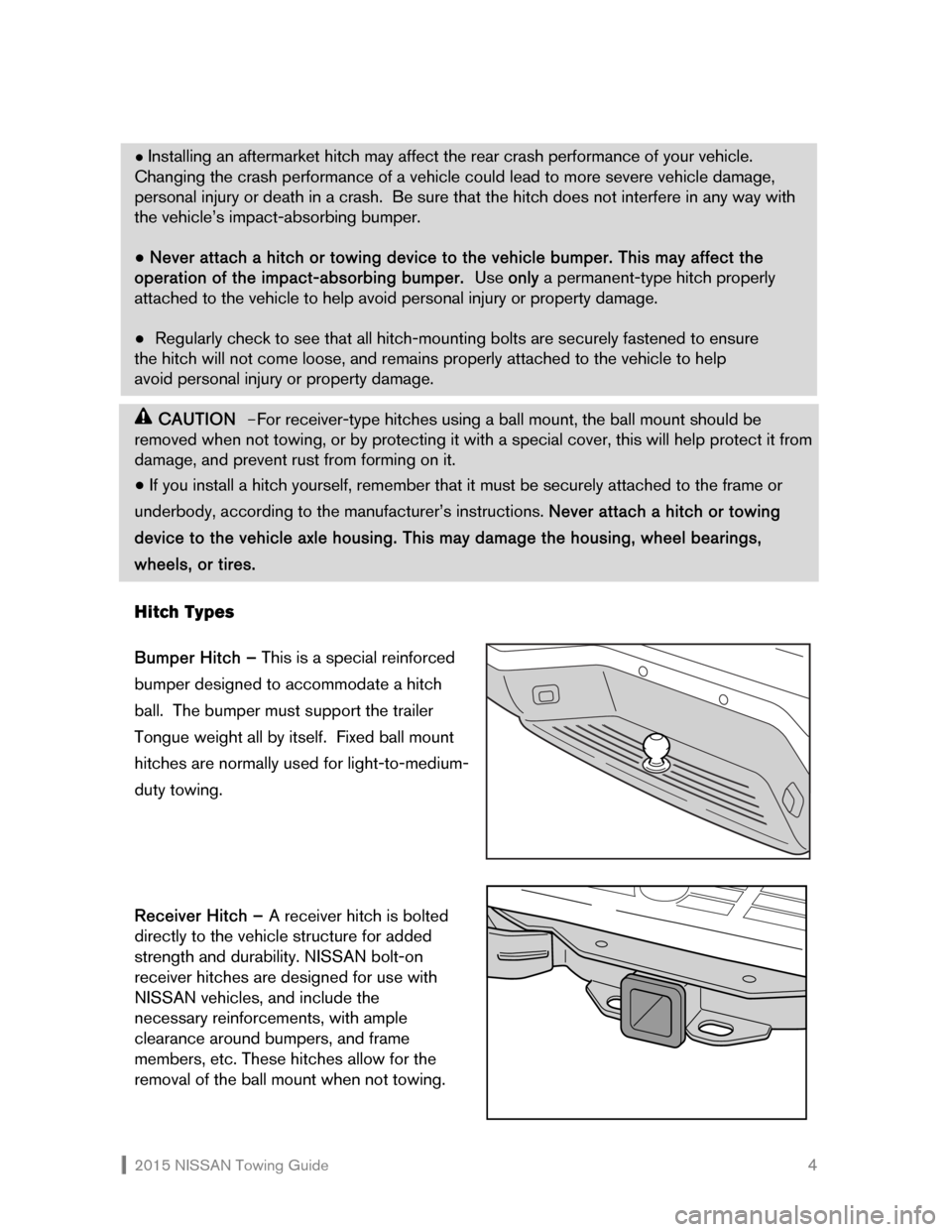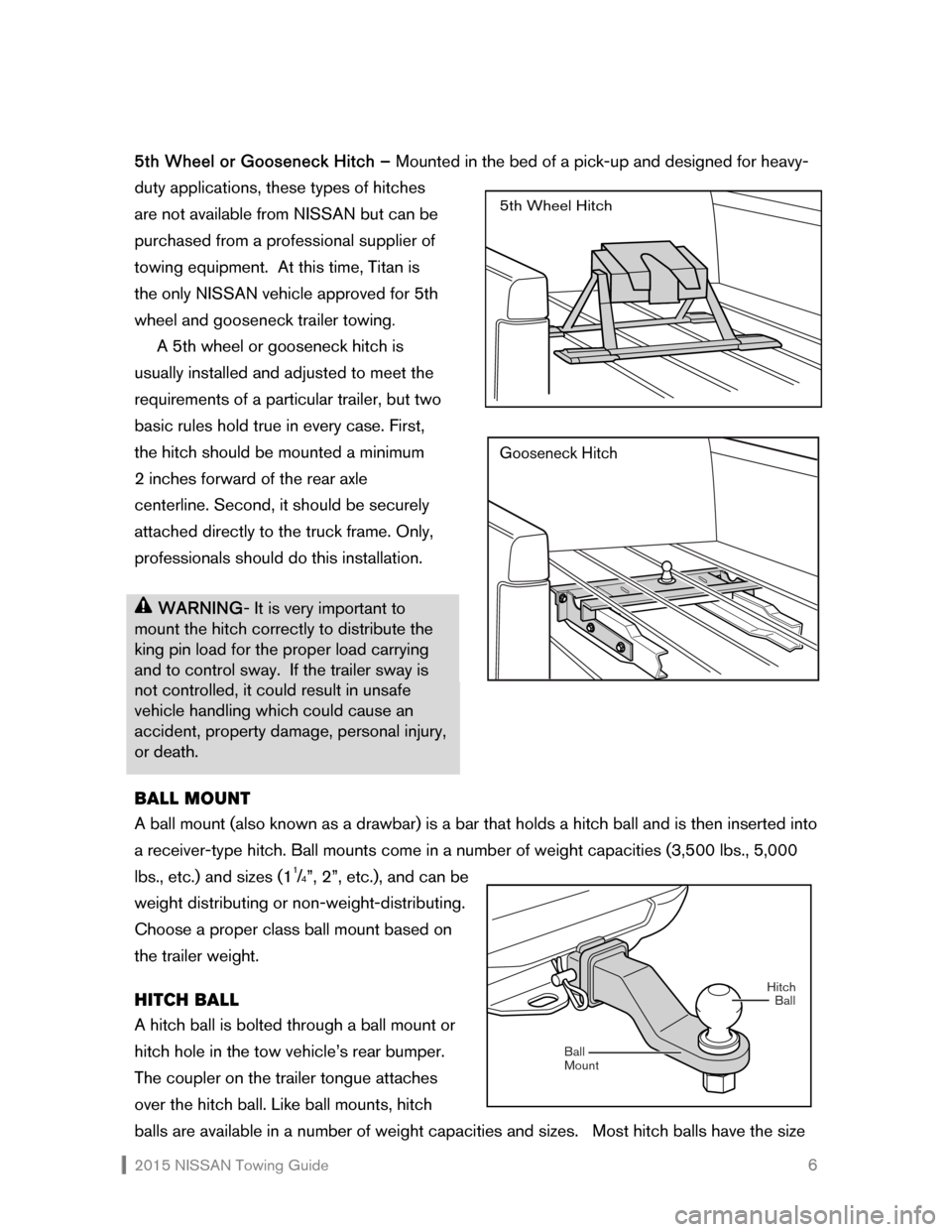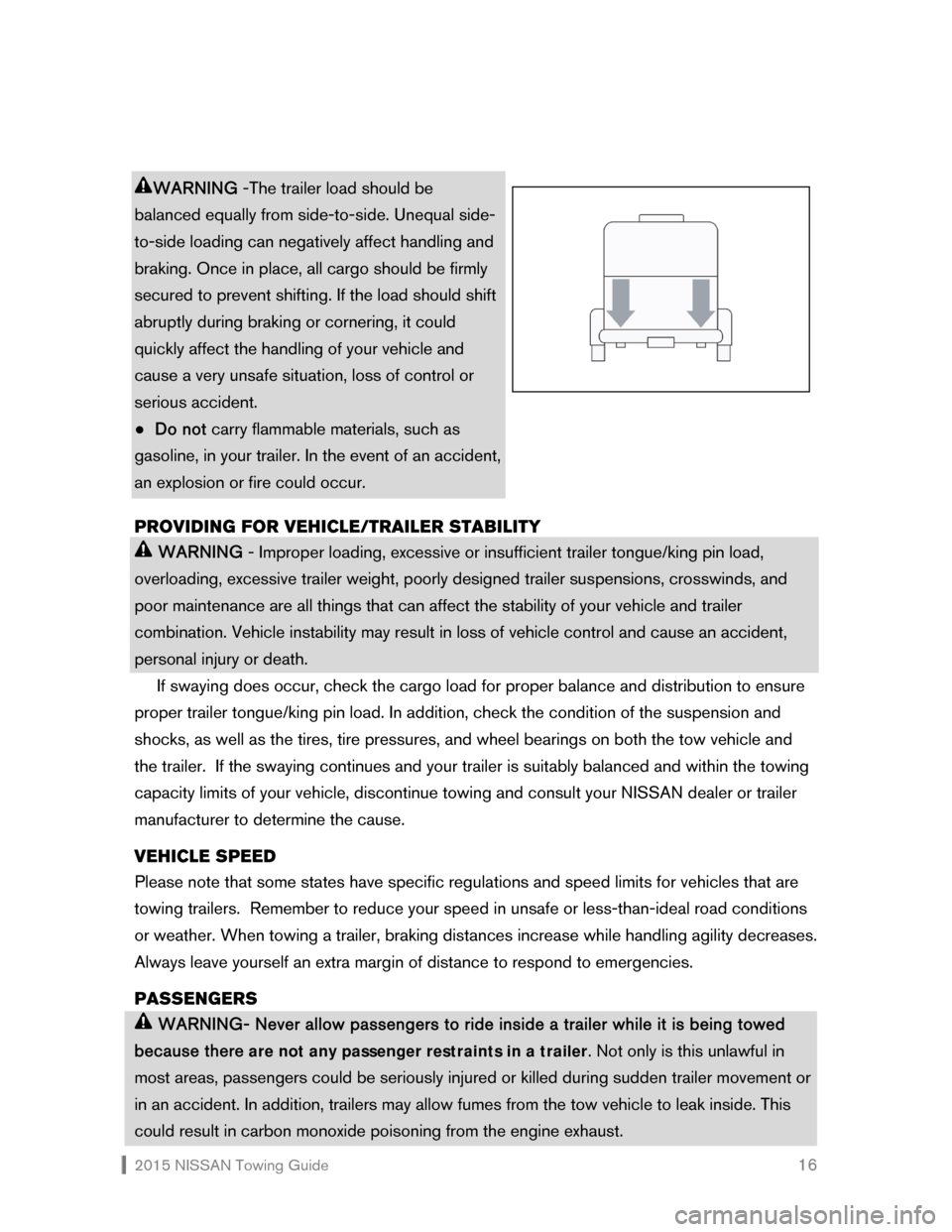2015 NISSAN GT-R ECU
[x] Cancel search: ECUPage 5 of 27

2015 NISSAN Towing Guide 4
● Installing an aftermarket hitch may affect the rear crash performance of your vehicle.
Changing the crash performance of a vehicle could lead to more severe vehicle damage,
personal injury or death in a crash. Be sure that the hitch does not interfere in any way with
the vehicle’s impact-absorbing bumper.
● Never attach a hitch or towing device to the vehicle bumper. This may affect the
operation of the impact-absorbing bumper. Use only a permanent-type hitch properly
attached to the vehicle to help avoid personal injury or property damage.
● Regularly check to see that all hitch-mounting bolts are securely fastened to ensure
the hitch will not come loose, and remains properly attached to the vehicle to help
avoid personal injury or property damage.
CAUTION -For receiver-type hitches using a ball mount, the ball mount should be
removed when not towing, or by protecting it with a special cover, this will help protect it from
damage, and prevent rust from forming on it.
● If you install a hitch yourself, remember that it must be securely attached to the frame or
underbody, according to the manufacturer’s instructions. Never attach a hitch or towing
device to the vehicle axle housing. This may damage the housing, wheel bearings,
wheels, or tires.
Hitch Types
Bumper Hitch – This is a special reinforced
bumper designed to accommodate a hitch
ball. The bumper must support the trailer
Tongue weight all by itself. Fixed ball mount
hitches are normally used for light-to-medium-
duty towing.
Receiver Hitch – A receiver hitch is bolted
directly to the vehicle structure for added
strength and durability. NISSAN bolt-on
receiver hitches are designed for use with
NISSAN vehicles, and include the
necessary reinforcements, with ample
clearance around bumpers, and frame
members, etc. These hitches allow for the
removal of the ball mount when not towing.
Page 7 of 27

2015 NISSAN Towing Guide 6
5th Wheel or Gooseneck Hitch – Mounted in the bed of a pick-up and designed for heavy-
duty applications, these types of hitches
are not available from NISSAN but can be
purchased from a professional supplier of
towing equipment. At this time, Titan is
the only NISSAN vehicle approved for 5th
wheel and gooseneck trailer towing
.
A 5th wheel or gooseneck hitch is
usually installed and adjusted to meet the
requirements of a particular trailer, but two
basic rules hold true in every case. First,
the hitch should be mounted a minimum
2 inches forward of the rear axle
centerline. Second, it should be securely
attached directly to the truck frame. Only,
professionals should do this installation.
WARNING- It is very important to
mount the hitch correctly to distribute the
king pin load for the proper load carrying
and to control sway. If the trailer sway is
not controlled, it could result in unsafe
vehicle handling which could cause an
accident, property damage, personal injury,
or death.
BALL MOUNT
A ball mount (also known as a drawbar) is a bar that holds a hitch ball and is then inserted into
a receiver-type hitch. Ball mounts come in a number of weight capacities (3,500 lbs., 5,000
lbs., etc.) and sizes (1
1/4”, 2”, etc.), and can be
weight distributing or non-weight-distributing.
Choose a proper class ball mount based on
the trailer weight.
HITCH BALL
A hitch ball is bolted through a ball mount or
hitch hole in the tow vehicle’s rear bumper.
The coupler on the trailer tongue attaches
over the hitch ball. Like ball mounts, hitch
balls are available in a number of weight capacities and sizes. Most hitch balls have the size
5th Wheel Hitch
Gooseneck Hitch
Hitch
Mount BallBall
Page 17 of 27

2015 NISSAN Towing Guide 16
WARNING -The trailer load should be
balanced equally from side-to-side. Unequal side-
to-side loading can negatively affect handling and
braking. Once in place, all cargo should be firmly
secured to prevent shifting. If the load should shift
abruptly during braking or cornering, it could
quickly affect the handling of your vehicle and
cause a very unsafe situation, loss of control or
serious accident.
● Do not carry flammable materials, such as
gasoline, in your trailer. In the event of an accident,
an explosion or fire could occur.
PROVIDING FOR VEHICLE/TRAILER STABILITY
WARNING - Improper loading, excessive or insufficient trailer tongue/king pin load,
overloading, excessive trailer weight, poorly designed trailer suspensions, crosswinds, and
poor maintenance are all things that can affect the stability of your vehicle and trailer
combination. Vehicle instability may result in loss of vehicle control and cause an accident,
personal injury or death.
If swaying does occur, check the cargo load for proper balance and distribution to ensure
proper trailer tongue/king pin load. In addition, check the condition of the suspension and
shocks, as well as the tires, tire pressures, and wheel bearings on both the tow vehicle and
the trailer. If the swaying continues and your trailer is suitably balanced and within the towing
capacity limits of your vehicle, discontinue towing and consult your NISSAN dealer or trailer
manufacturer to determine the cause.
VEHICLE SPEED
Please note that some states have specific regulations and speed limits for vehicles that are
towing trailers. Remember to reduce your speed in unsafe or less-than-ideal road conditions
or weather. When towing a trailer, braking distances increase while handling agility decreases.
Always leave yourself an extra margin of distance to respond to emergencies.
PASSENGERS
WARNING- Never allow passengers to ride inside a trailer while it is being towed
because there
are not any passenger restraints in a trailer. Not only is this unlawful in
most areas, passengers could be seriously injured or killed during sudden trailer movement or
in an accident. In addition, trailers may allow fumes from the tow vehicle to leak inside. This
could result in carbon monoxide poisoning from the engine exhaust.
Page 18 of 27

2015 NISSAN Towing Guide 17
VEHICLE MODIFICATIONS
CAUTION - DO NOT modify your vehicle beyond those required for proper hitch
installation, wiring hook-up, or adding extended mirrors on any NISSAN vehicle being used
for towing purposes. Changes to the drivetrain, suspension, exhaust systems, frame
structure/unibody, or other vehicle components are not necessary for towing within the limits
described in this guide. These changes may diminish the reliability and longevity of your
vehicle, void warranty coverage or possibly result in loss of vehicle control and cause an
accident, personal injury or death.
TOOL KIT
When towing, bring tools including, flares, a flashlight, emergency reflectors, jumper cables,
extra fuses, extra radiator coolant, oil, and easily replaced spare parts such as taillight bulbs.
You should also carry spare tires for your tow vehicle and trailer, as well as a jack suitable for
use on the trailer. A trailer jack is an important part of safe towing. Choose a jack that can
raise and lower the trailer so that you can connect the coupler to and disconnect it from the
ball of your hitch. Choose one with a weight capacity that matches or surpasses your trailer
tongue weight.
WARNING - Be aware that your automotive jack is designed for lifting only your vehicle
during a tire change. Using an automobile jack to lift a trailer bearing load, may be unstable
possibly causing it to fall off the jack stand which may result in property damage or serious
injury.
BEFORE STARTING OUT
Before starting out on a trip, make one last inspection of the tow vehicle and the trailer. Are
the tire pressures correct? Are the safety chains/cables securely in place? Has the cargo
been tied down securely? Do all the lights work? Is the coupler properly attached over the
hitch ball and secured using a locking pin? Is the breakaway switch hooked up and
functioning properly? Are vehicle and electric trailer brakes working properly?
Make a checklist of key items to inspect. Before towing, always check the tow vehicle’s
engine oil, transmission oil, and coolant before starting out. Finding a potential problem while
in your driveway is better than discovering it miles from home.
TOWING TIPS/ CAUTIONS & WARNINGS
If you have never towed a trailer before, be aware that it does take getting used to. To begin
with, towing noticeably affects your vehicle’s performance:
Page 25 of 27

2015 NISSAN Towing Guide 24
PROTECTION
At NISSAN, we back everything we build. Therefore, we are proud that every NISSAN is
protected by some of the best New Vehicle Limited Warranties, including a 36
month/36,000-mile basic coverage. All 2015 models also feature 60 month/60,000-mile
Limited Powertrain Warranty.* And, NISSAN warranties are completely transferable if you
should sell your NISSAN.
If you want additional peace of mind, we proudly offer the NISSAN Security+Plus
® Vehicle
Protection Plan. This plan offers quality mechanical protection long after your New Vehicle
Limited Warranty expires. The Security+Plus Vehicle Protection Plan is backed by NISSAN
and designed exclusively for NISSAN owners. From a variety of plans available, you can
choose the one that best fits your driving needs (up to 7 years/100,000 miles!). For the
maximum coverage, you will want to opt for Security+Plus Gold
® Preferred.
Whichever plan you choose, coverage is available throughout the United States. Repair work
will be done at authorized NISSAN dealers by NISSAN-trained technicians utilizing Genuine
NISSAN Parts. For more information about Security+Plus Vehicle Protection Plans, contact
your participating NISSAN dealer.
The quality of Genuine NISSAN Parts and Accessories is backed by the integrity of a
Genuine NISSAN Replacement Parts and Accessories Limited Warranty. If purchased within
the basic coverage period of 36 month/36,000 miles, Genuine NISSAN Parts and
Accessories are covered by the remaining period of the warranty. If the remaining period is
less than 1 year/12,000 miles (or if the vehicle warranty has expired), then Genuine NISSAN
Accessories are covered by their own 1-year/12,000-mile Limited Warranty. See your
NISSAN Warranty Information Booklet or ask your NISSAN dealer for specific details.
* For complete warranty details, read the NISSAN Warranty Information Booklet or see your nearest
NISSAN dealer.
Page 26 of 27

2015 NISSAN Towing Guide 25
CONCERN FOR YOUR SAFETY
NISSAN urges you to always use your seat belt whenever you drive. Also, please make sure
all passengers are buckled up. Keep in mind that air bags are a supplemental restraint system
and must always be used in conjunction with a seat belt.
In addition, a rear-facing child restraint must never be used in the front passenger seat if
the vehicle is equipped with a front passenger air bag. Children 12 and under should ride in
the rear seat properly secured in child restraints, booster seats, or seat belts, according to
their size. See your vehicle owner's manual for more details.
COMMITMENT
At NISSAN, our commitment to your satisfaction extends well beyond building a full line of
quality products. It begins with people dedicated to designing vehicles to satisfy your needs.
Then, building them to standards that are beyond your expectations. Our nationwide network
of nearly 1,100 dealers will help you select the NISSAN that is right for you.
For further assistance, search our Web site at www.NISSANUSA.com. For NISSAN dealer
locations or for more information on this and other NISSAN products, call 1-800-239-8810.
Or, call 1-800-NISSAN-1 for answers to product-related issues and solutions to your
transportation needs.